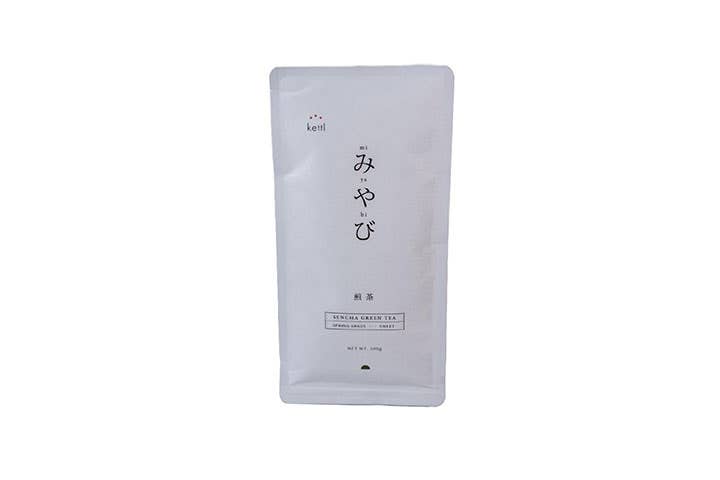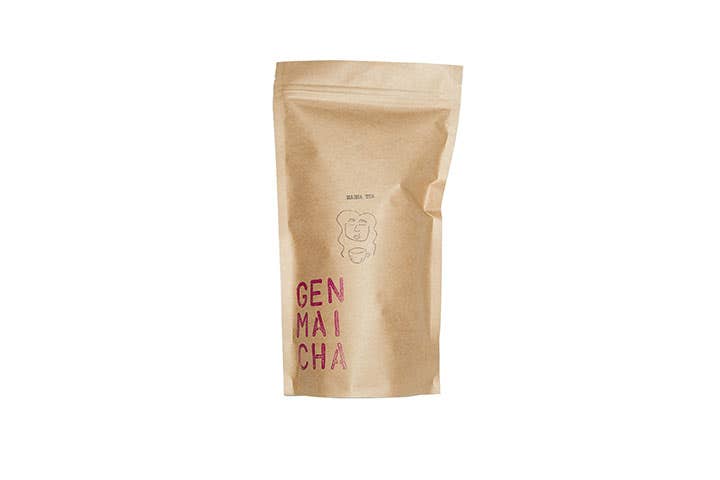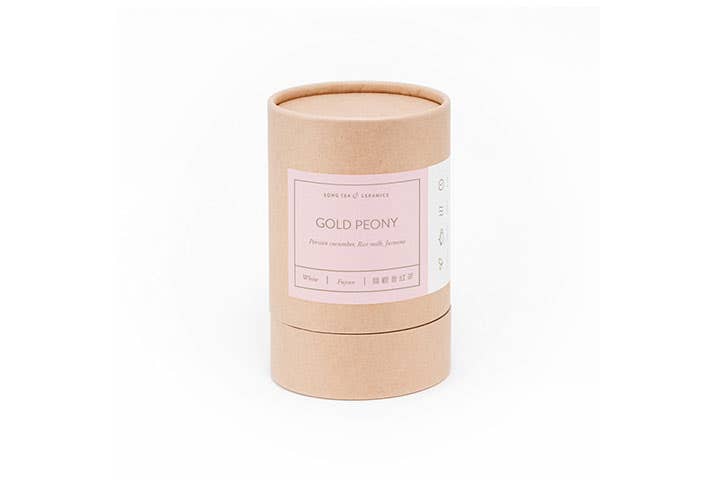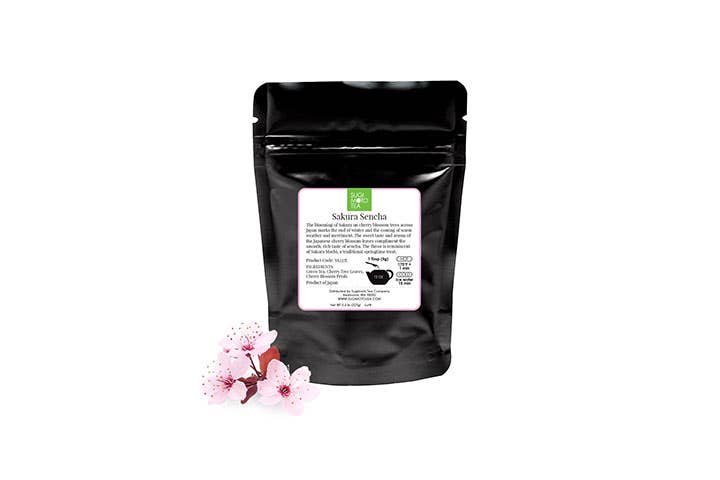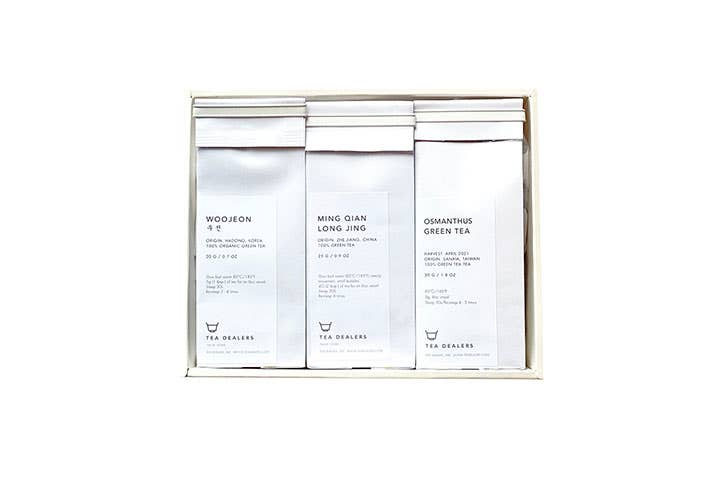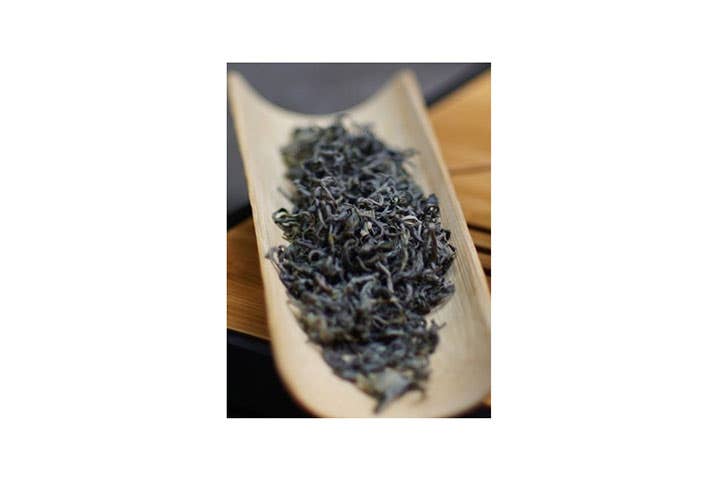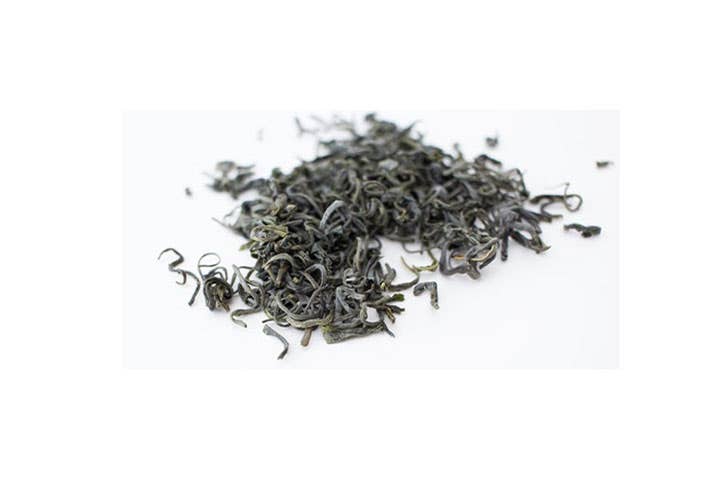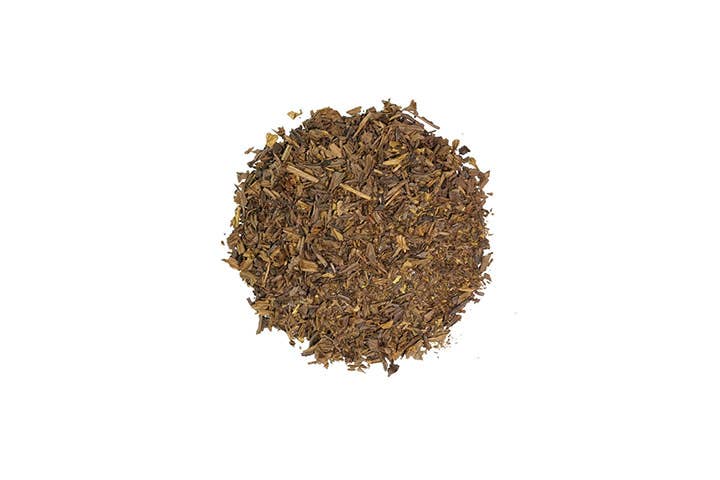The Best Green Teas To Try In 2022
Plus, expert advice on what to look for and the two tea making accessories you definitely need.
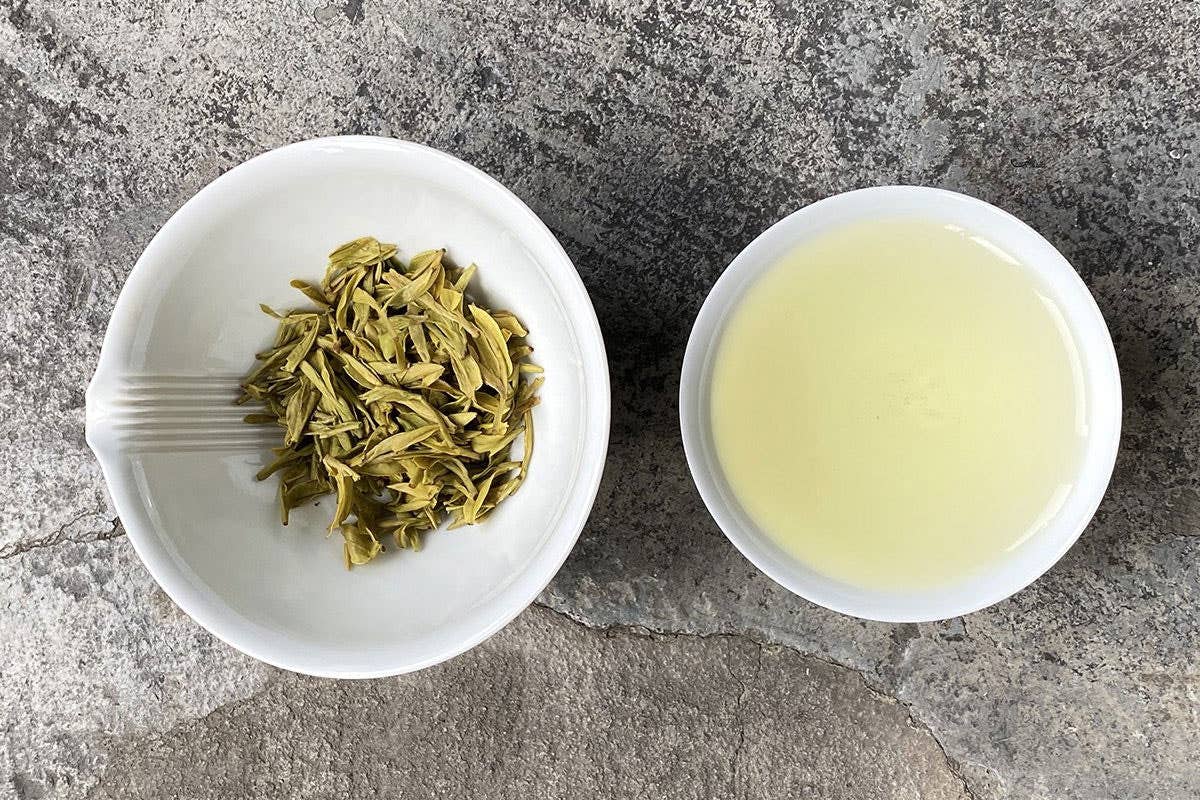
There are tea drinkers and then there are tea drinkers–people for whom tea is more than just a breakfast beverage or a coffee alternative. Stefen Ramirez, the founder and tea buyer of Tea Dealers, definitely falls into the latter category. Since developing an interest in tea, he’s become an upper-level tea practitioner and spent two years studying at a 400-year-old tea ceremony school in Kyoto. He now works with farms throughout Asia to source premium teas and award-winning cultivars.
Peter Luong is another tea connoisseur. The founder and tea sourcer of Song Tea & Ceramics, he grew up drinking oolong and red teas and still remembers the first truly memorable green tea he tried (more on that later). “Greens are special because there is very little done to craft them, so they reflect the quality of the growing region and the time of year when they are harvested,” he says.
We tapped Ramirez, Luong, and some of our other favorite industry experts to find out what green teas they’re excited about. Below are some of the best green teas from a variety of countries, eight amazing retailers, and a boxed set that would make a beautiful present…if you can bear to give it away.
Our Top Picks
- Best Everyday: Kettl Tea Miyabi Sencha
- Best Mixed Green: Masha Tea Genmaicha
- Best Newbie: Song Tea & Ceramics Huang Mudan
- Best Add In: Sugimoto Tea Sakura Sencha
- Best Exploratory Set: Tea Dealers Green Tea, My Favorite Color Boxed Set
- Best Korean: T Shop Hadong Green Tea
- Best Cloud Mist: Steep LA Cloud Mist Green Tea
- Best For Cocktails/Mocktails: Rare Tea Cellar Emperor's Golden Hojicha
Best Everyday: Kettl Tea Miyabi Sencha
Best Everyday
Type: Sencha | Flavor: “sweet, hazelnut, subdued umami” | Organic: No | Size: 100 grams | Source: Fukuoka, Japan
What We Like
- A stunning balance of umami and sweetness
- Subscription model offers 15% off but it can also be purchased as a one off
- It’s Kettl Tea’s number one selling sencha
Worth Noting
- Not certified organic, but it is third party tested for pesticides, heavy metals, and radiological materials
Why we chose it: The balanced depth of flavor makes this tea a joy to sip any time of day. Trying this tea and tracking down its maker inspired the creation of Kettl Tea; the founder/CEO still drinks each morning.
Gifted this tea from a friend returning from Japan, Zach Mangan loved it so much he made plans to visit the tea maker, where he found inspiration to start Kettl Tea. The first tea Mangan imported to the US, it’s one the founder and CEO still drinks each morning. “The unique terroir, manufacturing technology, and advanced understanding of plant biology make Japan unlike any other tea origin,” he says. “Steaming is the most unique step in processing that adds a depth and richness to Japanese green tea found nowhere else.” Kettl came up with a number of experts we spoke to about the best green teas.
Best Mixed Green: Masha Tea Genmaicha
Best Mixed Green
Type: Genmaicha | Flavor: “toasted rice, grassy” | Organic: Yes | Size: 70.8 grams or 1 pound Source: Shizuoka, Japan
What We Like
- This tea is organic
- Monthly subscriptions are available
Why we chose it: This organic, single-origin genmaicha is from a buzzy tea brand founded by a Brooklyn naturopath.
Founded by naturopath Dr. Maria Geyman, ND, Masha Tea has a small but mighty selection of organic teas, including this genmaicha. Anna Polonsky, the creative director of Polonsky & Friends, is a big fan. “Her sourcing is of the utmost quality and all of her packaging is sustainable,” Polonsky says.
Genmaicha is made of green tea leaves (often sencha) mixed with unprocessed brown rice that has been soaked, steamed, roasted, and then popped. “We recently started sourcing from a small farm in the Shizuoka Prefecture of Japan,” says Geyman, ND. “The family switched to organic farming in 1976 at a time when virtually no tea farms in Japan were organic. We also love that they use organic brown rice.”
Best Newbie: Song Tea & Ceramics Huang Mudan
Best Newbie
Type: Huang Mudan or Yellow Peony | Flavor: “Notes of marigold, pineapple, and fresh peppercorn” | Organic: Yes | Size: Four sizes between 30 grams and 240 grams | Source: Fujian, China
What We Like
- This cultivar was developed and released by the Wuyi Tea Research Institute, considered a “visionary producer” by Luong
- From an organic garden
- Multiple sizes available
Worth Noting
- The $40 size, Song’s smallest, only includes 5 to 8 servings of tea
Why we chose it: A unique cultivar from an experimental producer that was sourced by one of our favorite tea sellers.
“The source garden is relatively new, and quite experimental,” says Luong. “Huang Mudan is one of these new varieties—the leaves are golden instead of green, and during harvest season, the rows of gold are strikingly beautiful. Its flavor profile is also quite unique for a green, with bright peppery notes that I have not come across in other green teas.”
While describing Song’s green teas, Luong mentioned his first memorable green tea experience. “I was at my family’s tea import business and it was a Dragonwell, a type of pan-roasted green from the eastern Chinese province of Zhejiang.” Song’s 2021 batch is sold out but they’re expecting the 2022 harvest. Sign up for the newsletter to get updates from the shop.
Best Add In: Sugimoto Tea Sakura Sencha
Best Add In
Type: Sencha | Flavor: “sweet taste and the aroma of sakura compliment the smooth, rich taste of the sencha and is reminiscent of Sakura Mochi, a traditional springtime treat” | Organic: No | Size: 1/2 pound or a 20 gram sample | Source: Japan
What We Like
- Not just blossoms but also the leaves
- It is nitrogen flushed and vacuum sealed in resealable foil bag to maximize freshness
- They offer sample sizes for sale, which is a low commitment way to test teas
Worth Noting
- Not organic
Why we chose it: Whatever the weather outside, this sencha blend is like springtime in a cup.
At Ten Thousand Waves, an award-winning Japanese-inspired spa/hotel with an on-site restaurant in New Mexico, Sugimoto is the tea of choice. Director and chief creative officer Deborah Fleig says that when designing Izanami, the on-site restaurant, the tea offerings were just as important as the sake menu.
“I discovered Sugimoto when attending the World Conference of Tea about ten years ago,” she says. “I was drawn to the fact that they are a three-generation, family-owned company that started small and grew into the sustainable, environmentally friendly, and award-winning business that it is today.” Instead of just using the cherry blossoms, this blend includes blossoms and leaves, which make for a more flavorful expression in combination with sencha leaves.
Best Exploratory Set: Tea Dealers Green Tea, My Favorite Color Boxed Set
Best Exploratory Set
Type: Three varieties from China, Japan, and Taiwan | Flavor: “Delicate smokiness, tropical fruit, green bamboo” ; Tropical fruit, pineapple, lemon rind” ; “balance of sweetness, slight astringency, green apple taste, beautiful bright green color in the cup” | Organic: No | Size: Kit contains one 25 gram bag and two 50 gram bags | Source: Zhe Jiang, China, Sanxia, Taiwan and Ureshino, Japan
What We Like
- A fun way to explore green tea from different places
- Would make a great gift
- Interesting flavor profiles
Worth Noting
- High quality comes with a high price tag
- Not organic, but all of Tea Dealers’ teas are tested by a third party of metals, pesticides, bacteria, and mold
Why we chose it: A boxed set that will please connoisseurs as much as beginners.
Boxed sets can be a mixed bag; some are great, others feel like a basket full of filler items. But Ramirez of Tea Dealers is meticulous in his sourcing and this kit is no exception. The three varieties included would be a fun entry point into green teas or a beautiful gift for a more seasoned tea drinker.
Best Korean: T Shop Hadong Green Tea
Best Korean
Type: Hadong | Flavor: “Savory, toasted grain, peanut” | Organic: No | Size: 8 grams sample or 1 ounce size (which is currently sold out) | Source: Hadong, South Korea
What We Like
- Hand picked in Korea
- This tea was crafted by a monk
- T Shop experts Theresa Wong and Hyun Lee source with care
Worth Noting
- The 1 ounce size is currently sold out, but the smaller sample size is great if you haven’t tried Korean greens
Why we chose it: A great opportunity to get to know Korean green tea better.
“T Shop is an excellent source of Korean teas that are seldom explored in the West,” says Nissan Haque, a Kintsugi artist who also works at the New York tea room. He likes the misty quality of this region and this cultivar in particular.
Best Cloud Mist: Steep LA Cloud Mist Green Tea
Best Cloud Mist
Type: Cloud Mist or Yunwu | Flavor: “Umami, Creamy, Orchid, Earthy, Light Savory, Light Astringent” | Organic: Not specified | Size: 20 grams |Source: Hangzhou, China
What We Like
- Available for pickup in LA or shipping nationwide
- Part of a well curated selection
Worth Noting
- Only one size available
Why we chose it: Steep LA’s two founders have settled on a tightly curated list of offerings, so each tea has to be worthy of a spot.
Steep LA is a calming counterpoint to the city’s high energy. The tea room is located in Chinatown and features a small, well-curated selection hand-picked by founders Samuel Wang and Lydia Lin. Maggie Xue, founder, and CEO of Us Two Tea, enjoys Steep LA’s cloud mist tea, which is grown in mountains where high humidity makes condensation common. Wang says it has a unique brothy, umami-rich taste as opposed to the grassiness commonly found in green teas.
Best For Cocktails & Mocktails: Rare Tea Cellar Emperor's Golden Hojicha
Best For Cocktails/Mocktails
Type: Hojicha | Flavor: has “an enticing, deep smoky aroma and round, mild flavor” | Organic: No | Size: ¼ pound or 1 pound | Source: Japan
What We Like
- Great for consuming in the late afternoon or at night, mixing in cocktails or mocktails, or for people sensitive to caffeine
- Rare Tea Cellar has a robust list of high end clients, a testament to their quality
Worth Noting
- Low caffeine level won’t give a strong caffeine boost
Why we chose it: This low-caffeine green tea is a quality option for late afternoons and evenings, whether it’s consumed in a mug or mixed into a mocktail/cocktail.
“I don’t believe in separating teas into ones meant to be enjoyed on their own versus ones meant to be mixed,” says Julia Momosé, the creative director of Kumiko, a cocktail bar in Chicago. She notes that an 18-year single malt can be savored neat or in a highball and when it comes to teas also thinks they should be enjoyed in a variety of ways.
That said, she’s fastidious about quality. “I wouldn’t work with Rodrick at Rare Tea Cellar if it wasn’t a quality product!” says Momosé. “I like working with importers who bring in smaller amounts of tea at a time, so I know the tea leaves haven't been sitting in a warehouse for three years.” Low caffeine, this hojicha is ideal for a late afternoon pick me up that won’t make falling asleep impossible later on. It’s also fantastic for cocktails and mocktails, like this green tea martini.
How We Chose These Products
We sought out experts in the field and green tea lovers in the food and beverage industry that we trust. We assessed quality, brand or retailer reputation, price, and how much information is provided about origin. We also looked for green teas that meet a variety of needs, come from different regions, and allowed us to showcase unique cultivars, worthy blends, and traditional greens.
Features to Keep in Mind When Shopping for Green Teas
Source Country and Taste
“The major distinguishing characteristic between Chinese, Korean, and Japanese green teas is the production method which creates a specific taste,” Ramirez says. “Generally speaking, Japanese green teas are steamed and result in a vegetal and very fresh taste like asparagus or green peas. Korean teas are pan-fired and the steam that comes off the leaves is used to semi cook the leaves. The result is a savory green tea, with a slight baked taste and a high amount of umami. Chinese teas are almost all pan-fired but have very specific shapes depending on the region. Chinese teas tend to use the highest temperatures when drying and result in beautiful delicate toasted notes. Chinese green teas are less vegetal or umami and have more pronounced tropical fruit and floral flavors.”
Color and Leaf Shape
Too many broken leaves or the presence of powder is not a good sign; leaves should be consistent in their small size. When it comes to tea color, Ramirez says green tea should pour clear, not cloudy.
Ethical Sourcing
“There are two separate concerns here,” says Luong, of Song Tea & Ceramics. “First, that the teas we source are ethically produced and that the producers and workers are justly and fairly compensated for their efforts. Second, the teas are sustainably produced in a manner that is environmentally sound. The first issue is less problematic because of how the tea labor market is structured in a lot of East Asian countries (China, Taiwan, Japan, Korea).” He notes that tea picking and production is a labor-intensive and specialized skill with a decreasing labor pool and, in turn, laborers can drive up prices they command. “Song sees this in the prices we pay for tea: Year to year, there’s an increase, and we are absolutely okay with it.”
As for the larger environmental concern, Luong says that “tea agriculture is by nature disruptive, and clearing fields for rows of tea bushes and building infrastructure into remote tea-growing regions is problematic.” But, Luong says, there are ways to mitigate the harm done. “We work with small producers with minimal impact, either because they harvest from wild, or semi-wild plots, or have been working the land at that location for decades, and/or follow organic methods. We do work with a very small handful of small conventional producers but require that their tea meets the EU standard, the most stringent conventional standard available.” Look for details about how the tea you’re buying is made and decide if it meets various standards that are important to you.
Preparation
Ramirez cites two essentials to make sure you’re getting the most out of your green tea, which is especially important to get the most out of quality teas that cost more than standard greens. “I consider a water filter and a weight scale that can measure grams absolutely essential over all other implements in tea. They have the biggest effect on the outcome of your tea making. All tea should be made using only purified or bottled water. Chlorine in tap water negates over 50% of the taste of tea and is 100% responsible for a lack of taste no matter the quality of your tea. A scale is a very important tool to help in brewing the right amount of tea and water.” A nice tea kettle won’t hurt either.
Ask the Experts
Q: How much green tea should I drink daily?
According to Healthline, drinking between three and five cups of green tea is optimal from a health perspective, as observational studies have suggested regular green tea consumption may lower the risk for several diseases including certain cancers, diabetes, and heart disease.
Q: Does green tea have an expiration date?
Not all green teas will include an expiration date, but they should. “Traditionally green teas were enjoyed during the first two to three months after processing in April since that is when they are at their freshest,” Ramirez of Tea Dealers says. “Due to modern technology, we are now able to enjoy the freshness of green tea throughout the year with the use of refrigeration and the elimination of oxygen. I strongly believe in the seasonality of tea and only purchase green tea once a year and allow it to naturally age through the year.” While green teas do lose freshness, storing them properly will help, as will buying from sources who take freshness seriously.
Q: What’s the best way to store green tea to keep it fresh?
An airtight container that offers UV resistance is the best way to store green tea. “The four factors that damage tea are oxygen, light, humidity and temperature, and foreign smells,” says Ramirez. The cabinet right next to the stove isn’t a good idea because of heat exposure, neither is a cabinet filled with a bunch of spices because those strong smells can also impact tea.
Q: Is it okay to buy tea in sachets?
Yes. Sachets are more expensive than traditional tea bags, so they’re often used for higher quality tea and whole leaf teas, which need more room to expand. For an on-the-go option that works with loose leaf teas, consider this very affordable pack of 100% biodegradable hemp tea sacs from Rare Tea Cellar.
Our Take
A mug of green tea is a great way to start the morning. Trustworthy retailers take the guesswork out of freshness and quality, resulting in a plethora of compelling options and new cultivars to learn about.
Keep Reading
Continue to Next Story
